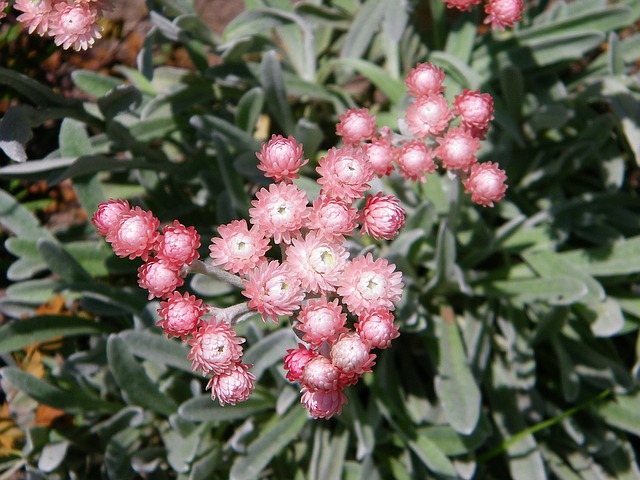 |  |  |  |  |
 |
Antennaria dioica is a perennial terrestrial rosette-forming herbaceous plant with a thin, horizontal, woody rhizome and fine roots. The erect, simple, white-woolly, flowering stems reach up to 30 cm in height and are usually solitary, though sometimes multiple stems grow on one plant. Numerous sprawling shoots form dense mats or turf-like carpets, with curled leaf rosettes at their tips. The basal leaves are blunt, spatulate, glabrous and green on the upper side, and white-woolly underneath, reaching up to 50 mm in length and 10 mm in width, gradually narrowing to a petiole at the base. The plant has 5 to 10 stem leaves, which are white-woolly on both sides, sessile, pressed against the stem, oblong-lanceolate or linear with a sharp apex.
The plant produces 3 to 15 flower heads (capitula), located on short, white-woolly peduncles, each up to 6 mm wide. The flower heads are arranged in umbels. The involucral bracts differ by sex: female flower heads have pink bracts, male ones have white bracts; the lower half of all flower heads is light green, with membranous upper parts. The outermost bracts at the base are slightly woolly, imbricate, and arranged in multiple rows. The small pistillate flowers are also pinkish or whitish, about 5 mm long, with a thin tubular corolla. The flower formula is *K5+5C5A∞G∞. The fruits are dry achenes with a pappus.
Harvesting of Raw Materials
The medicinal raw material of Antennaria dioica consists of the herb, known in pharmaceutical practice as Herba Antennariae dioicae, and the flower heads, referred to as Flores Antennariae dioicae. They are collected during the flowering period, which for Antennaria dioica falls between May and June. It is very important to harvest the flower heads before they are fully open, but they must be well-formed. Flower heads collected too early are too small and unsuitable for use, as are those collected too late, since the flowers begin to fall off. The cut herb and flower heads are dried in the shade, in fresh air, or in well-ventilated, dry, and warm rooms.
Chemical Composition
The chemical composition of the plant is not well studied. However, research has identified saponins and phytosterols, tannins, bitter and resinous substances, as well as vitamins K and C, octacosane, phylloquinone, and essential oil in Antennaria dioica (Mountain Everlasting).
Pharmacological Properties
The medicinal effects of Antennaria dioica (Mountain Everlasting) were studied at the Sverdlovsk Medical Institute. Research showed that the plant possesses antispasmodic and choleretic (bile-stimulating) properties. Its use proved effective in treating pronounced functional disorders of the gallbladder and bile ducts, especially those accompanied by the hypertensive form of dyskinesia, as well as chronic cholecystitis.
The plant’s hemostatic (blood-stopping) effect is due to the presence of tannins and vitamin K. In terms of blood clotting ability, Antennaria dioica surpasses calcium chloride and adrenaline.
Use in Traditional Medicine
Antennaria dioica (Mountain Everlasting) has found applications in traditional medicine. Infusions made from the herb or flower heads are taken orally to stop internal bleeding—such as stomach, intestinal, and lung hemorrhages. Externally, the infusion is used to stop nosebleeds, bleeding gums, open wounds, eczema, jaundice, and childhood diathesis. Poultices are applied to abscesses, bruises, tumors, hardening in the mammary glands, as well as for eye diseases such as leukoma, cataracts, and glaucoma.
A salve prepared from the decoction is effective for treating furunculosis and for wound healing. Open wounds are also dusted with powder made from the dried plant. In gynecology, Antennaria dioica is used to treat uterine bleeding, menstrual cycle disorders, and leukorrhea; baths made from the decoctions are also effective for hemorrhoidal bleeding. The plant’s decoctions are used to treat diseases of the gallbladder and liver, and its infusions are recommended for high blood pressure, as a calming and mild sleeping aid.
